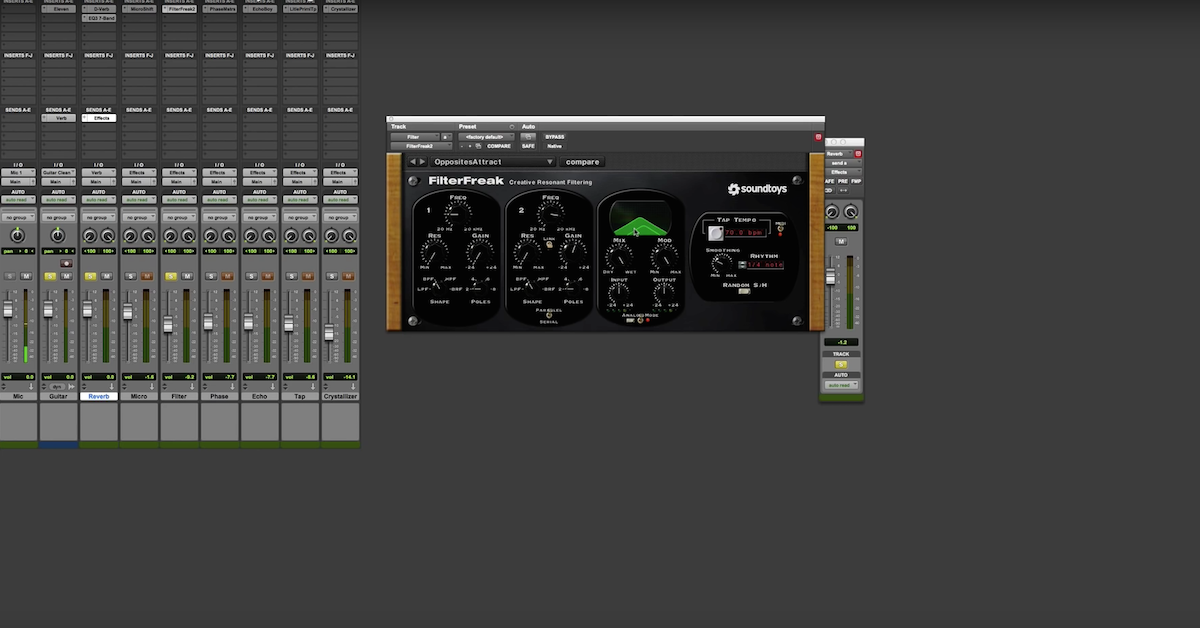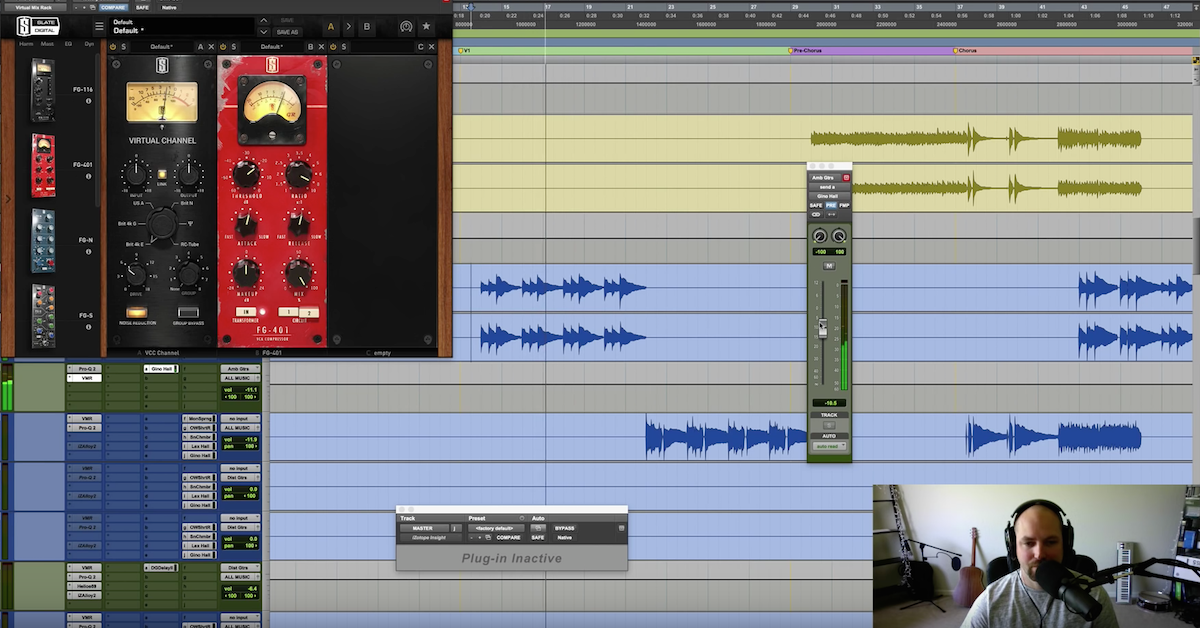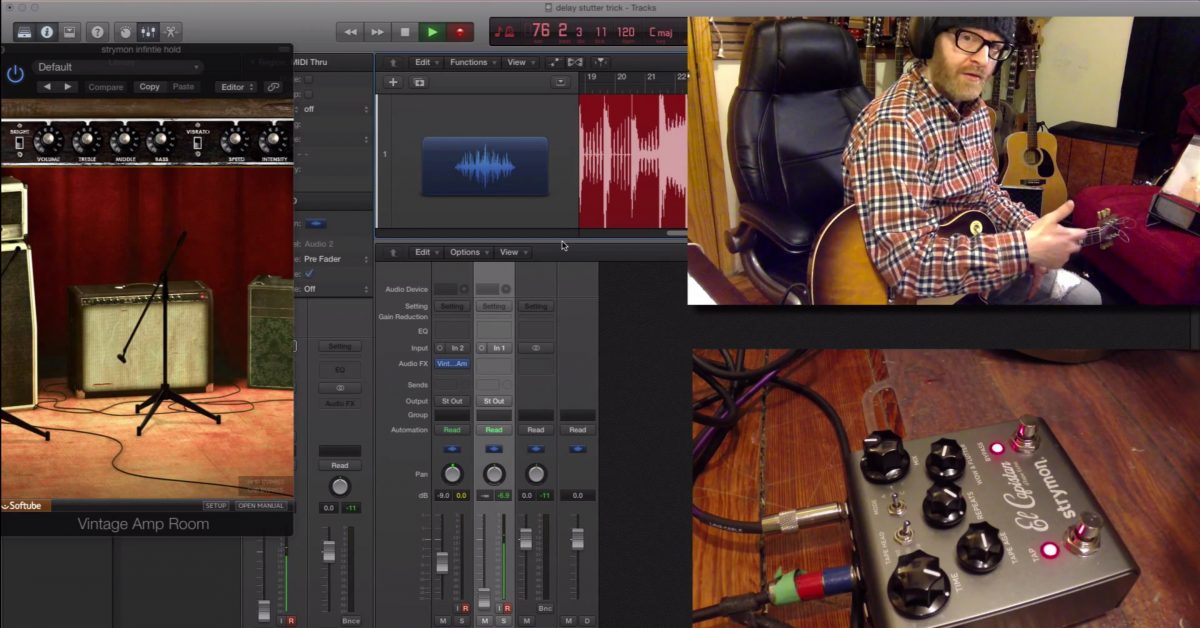How to Create an 80’s Electric Guitar Vibe
I wanted to share a technique that I’ve been using lately, specifically how to get a 1980’s sounding electric guitar. It seems like no matter where I listen, there are productions that have that 1980’s vibe. So the 80’s are in again, and fortunately, we’ve got Universal Audio, who always does a great job of emulating vintage gear with their plugins.
So in the latest update, we’ve got the Korg SDD 3000 digital delay, the AMS RMX 16 expanded, which is a digital reverb, but also has some other capabilities, and we’re going to talk about a couple of other plugins.
So let’s check out this Pro Tools session. So I’m going to play the chorus of this production that I’m working on, and keep in mind, it’s a work in progress.
[mix]
Okay, so what I heard in my head was this almost dense, repeated delay on top of this picky guitar part, and then another more stabby, staccato performance with a dotted note delay added to that.
It’ll make more sense as I add these plugins. I’m going to add in these guitars, and it’s going to sound really weird, because part of the process here is that I had the sound in my head, and I knew that it would take some tool to achieve that sound. It was not something that was just kind of going to come out of my guitar.
[mix]
Let’s actually take a listen to these guitars soloed, and mind you, these are recorded without any effects, and they are direct going into my Apollo, so they don’t have any processing on them yet, and they are also — you know, direct guitar is not my favorite sound. They don’t have the character of an amplifier or the space, so let’s take a listen.
[guitars]
Yeah, so not a great part, not really interesting, and I was really relying on my ability to achieve the tone that I wanted with plugins for my overall vision here, so let’s add the amp simulators first. We’ve got this ENGL amplifier, which is new to this update from Universal Audio. We’ve got these Fuchs overdrive amplifiers, which for each of these, I took a bit of time to develop the sound. I wanted a clean sound, I didn’t want distortion, because I am going to be applying delay to these, so let’s take a listen here and I also added dbx 160 compressors, just to even out the signal a little bit.
[guitars with plugins]
So now, let’s add in the Korg SDD 3000 digital delay. This is where it starts to get fun. Thanks for being patient.
[guitars with delay]
Okay, great. So some things to know about this plugin, it will sync up to your DAW, which is excellent, and I really suggest working with the delay time here, right? Because if I changed it to a quarter note, it’s going to sound entirely different, and actually going to add a much different feel to the music than an 8th note dotted, which is exactly what I was going for.
Let’s take a listen to what it would sound like with something like this.
[guitars with 8th delay]
And in the context of the mix, definitely wouldn’t work.
[mix]
Let’s go back here.
[song]
There we go. Right in the pocket. This is sort of a Pro Tools situation here where I go in and if my performance is a little bit off, just a little bit, I am going to edit it so those staccato guitar stabs are exactly, exactly in unison together, and right on the grid, because think about the 80’s. You’ve got a lot of precision and very clean era of recording, and so I really want to emulate that.
Of course, I should probably just perform it correctly, but here we are.
So we have a great amount of control over the sound of the delay with this plugin. In addition to having control of the delay time, we also have this regeneration section, which allows us to control the amount of feedback, and apply filters to the repeats.
We also have this really unique and interesting modulation section. So one of my favorite things about the 80s is that warbly, detuned, synthesizer sound, and this really can help achieve that effect, not only on synthesizers, but guitar, or whatever source you apply it to. Let’s have a listen.
[guitar with delay modulation]
So my goal with this sound was to keep it pretty subtle. We also have an attenuator section. We can drive this plugin really hard and it will distort the repeats, which is an interesting thing to be able to do. It’s great to be able to have that option if we want. We have a dry/wet blend, and we can change the position left or right of the repeats.
So really, a lot of control in shaping the tone of the delay.
Okay, so let’s check out the AMS RMX 16. I am actually using this plugin as more of a chorus effect. Typically, you’re going to find this does a great job on 80s sounding reverbs, you’ve got some really great gated sounds, some ambiences, but I really just toggled through the presets here, and modify them a little bit, and in fact, in this particular case, since this is a work in progress, I’m just going to settle on it, and when it comes down to final mix, I will tweak it.
So that’s the great thing about a lot of these plugins. You can work as you go, and get sounds that are ballpark, and then when it’s time to finish, you finish.
So I got this E guitar funky chorus sound, and let’s have a listen to that.
[E Guitar, funky chorus]
And this is without.
[E Guitar, no chorus]
So a much wider sound. Let’s hear it altogether.
[mix]
So let’s talk for a minute about my routing. I have one instance of the Fuchs amplifier on each of the picky guitar parts, because I believe I’m going to want to go in and dial in a specific sound for each. They might not be identical.
I’ve got a dbx 160 after to even out the level. But for these staccato parts here, I simply routed all of them together to a stereo guitar aux, because I think of them almost as one guitar. So they are each being processed through this ENGL amplifier plugin, and again, a dbx afterwards.
I have — each of these picky guitars are going to the reverb and delay, and the stereo guitar is going to the reverb and delay as well, and I actually am sending the delay to the reverb aux.
As you can see, I initially intended it on being a reverb, but I ended up using this chorusy effect. So let’s change that.
So generally, what I’ll do when I’m coming up with a part like this is I will run an instance of an amplifier as a Unison plugin on the channel, and perhaps a reverb or a delay or something like that as an insert, and I’ll experiment and get the sound I want, because part of the performance is dependent on the sound. So I’ll do that, and I will not print it or commit it to Pro Tools, and then I will go and record the direct part into Pro Tools. That way, I can then experiment with changing the tone and the delay type afterwards.
So I hope this has been helpful, guys. Universal Audio doing a great job of making fun tools to use while production is still happening, and of course during mixing and mastering. So if you have any questions, let me know.
Again, this has been Ian Vargo with The Pro Audio Files. Thanks!





